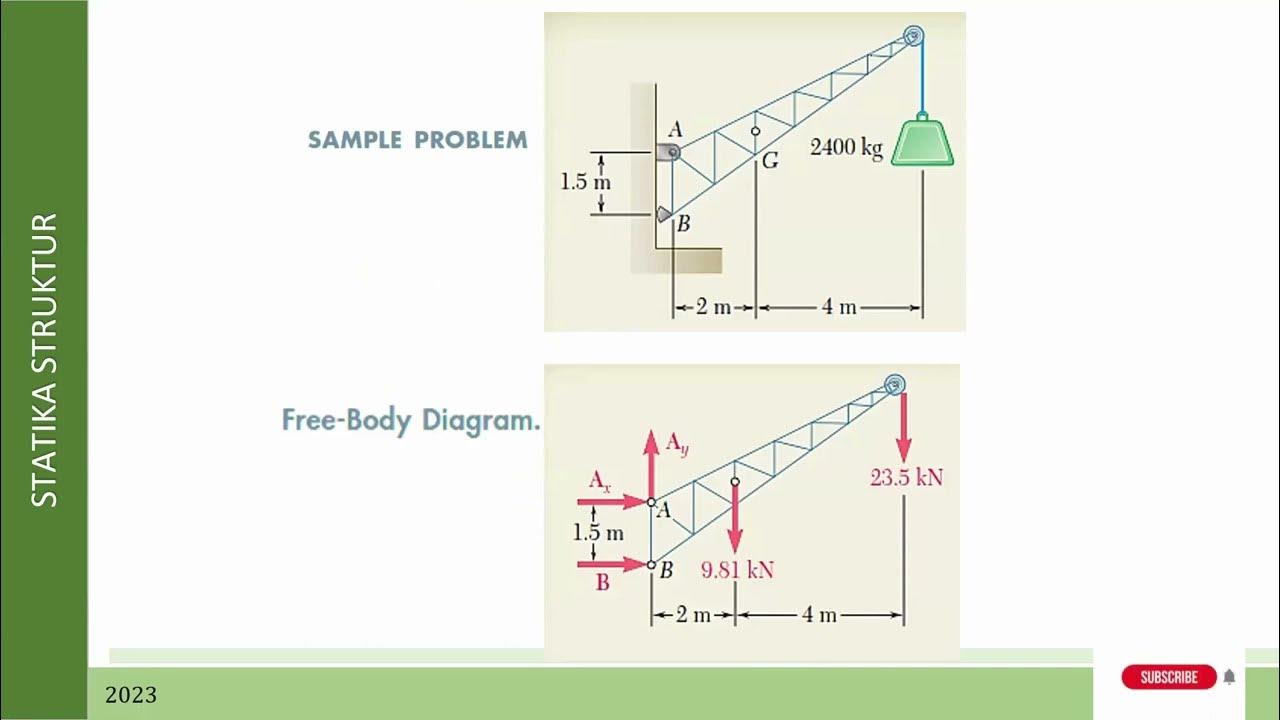Understanding and Analysing Trusses
Summary
TLDRThis video provides a comprehensive overview of trusses, explaining their significance in engineering structures like bridges and cranes. It defines trusses as rigid frameworks made of straight members, emphasizing the critical assumptions of pinned connections and load application at joints. The video discusses two primary analysis methods—Method of Joints and Method of Sections—illustrating how to determine internal forces within trusses. Additionally, it highlights various truss designs, such as the Howe, Pratt, and Warren trusses, and explores how loads affect member tension and compression. The content is valuable for understanding truss mechanics and design principles.
Takeaways
- 🏗️ Trusses are widely used in various structures, including bridges, cranes, and even the International Space Station, due to their efficiency and strength.
- 🔗 A truss is a rigid structure composed of straight members connected at joints, which ideally act as pinned connections to simplify analysis.
- ⚖️ The analysis of trusses assumes that loads are applied only at the joints, allowing members to carry only axial loads, not bending moments.
- 🔺 The fundamental shape of a truss is the triangle, which provides stability and prevents deformation under load, making it a reliable base for larger structures.
- 🔍 Two primary methods for analyzing trusses are the Method of Joints and the Method of Sections, each suited for different scenarios.
- 📏 The Method of Joints involves drawing free body diagrams for each joint to determine the forces acting within the members, using equilibrium equations.
- 🧮 In the Method of Sections, an imaginary cut is made through the truss to focus on specific members of interest, applying equilibrium equations to find internal forces.
- 📉 Zero force members can occur in certain configurations where no external loads are applied, helping to enhance stability without carrying loads.
- 💰 Different truss designs, such as the Howe, Pratt, and Warren trusses, have varying efficiencies based on how they distribute tension and compression in their members.
- 🌌 Space trusses, which can be assessed in three dimensions, use similar analysis methods as planar trusses but involve additional equilibrium equations.
Q & A
What are trusses used for?
-Trusses are used in various structures, including bridges, antenna towers, cranes, and even parts of the International Space Station, due to their ability to create strong and efficient structures.
What are the two key assumptions for a structure to be considered a truss?
-The two key assumptions are: 1) all joints are pinned connections allowing rotation, and 2) loads are only applied at the joints, with members carrying only axial loads.
How do pinned connections influence the behavior of truss members?
-Pinned connections mean that members cannot carry bending moments, simplifying the analysis as they can only support axial loads, which are either tension or compression.
What is the significance of using triangular shapes in truss design?
-Triangular shapes are stable and do not deform under load, making them an excellent base for constructing larger trusses because their angles remain unchanged when loads are applied.
What are zero force members in a truss, and when do they occur?
-Zero force members are members that carry no loads. They occur in two configurations: when three members meet at a joint with two aligned, or when only two non-aligned members meet without external loads.
What are the Method of Joints and the Method of Sections?
-The Method of Joints involves analyzing each joint in a truss to determine the internal forces, while the Method of Sections involves making an imaginary cut through the truss to analyze specific members of interest.
How do you determine the forces in a truss using the Method of Joints?
-First, draw a free body diagram to determine reaction forces, then analyze each joint's equilibrium using three equations to calculate the internal forces acting on the members.
What are the differences between Howe, Pratt, and Warren trusses?
-The Howe truss has vertical members in tension and diagonal members in compression, making it less cost-effective. The Pratt truss has vertical members in compression and diagonal members in tension, which is more economical. The Warren truss uses equilateral triangles, allowing for uniform member lengths and reduced material use, with alternating tension and compression.
Why might a structure be classified as statically indeterminate?
-A structure is statically indeterminate if it has more members than needed for stability, making it impossible to determine internal forces and reactions using equilibrium equations alone.
What is a space truss, and how does it differ from a planar truss?
-A space truss is a three-dimensional structure that can be analyzed using similar methods as planar trusses but involves six equilibrium equations instead of three, accounting for forces in three dimensions.
Outlines

Dieser Bereich ist nur für Premium-Benutzer verfügbar. Bitte führen Sie ein Upgrade durch, um auf diesen Abschnitt zuzugreifen.
Upgrade durchführenMindmap

Dieser Bereich ist nur für Premium-Benutzer verfügbar. Bitte führen Sie ein Upgrade durch, um auf diesen Abschnitt zuzugreifen.
Upgrade durchführenKeywords

Dieser Bereich ist nur für Premium-Benutzer verfügbar. Bitte führen Sie ein Upgrade durch, um auf diesen Abschnitt zuzugreifen.
Upgrade durchführenHighlights

Dieser Bereich ist nur für Premium-Benutzer verfügbar. Bitte führen Sie ein Upgrade durch, um auf diesen Abschnitt zuzugreifen.
Upgrade durchführenTranscripts

Dieser Bereich ist nur für Premium-Benutzer verfügbar. Bitte führen Sie ein Upgrade durch, um auf diesen Abschnitt zuzugreifen.
Upgrade durchführenWeitere ähnliche Videos ansehen

Teori Dasar Struktur Truss: Persamaan/Rumus, Reaksi Tumpuan, Gaya tarik atau tekan (T atau C)

Hooke’s Law — Lesson 2

Structural Theory 1 Chapter 1 Part III (with Subtitles)

Plastic Hinges

My Entire Civil Engineering Degree in 9 Minutes

Mengenal Jenis - Jenis Konstruksi Jembatan Bersama Spesialis Konstruksi | SpeciaLIST#17
5.0 / 5 (0 votes)
